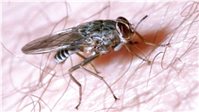题型:阅读理解 题类:模拟题 难易度:普通
江苏省兴化一中2018届高三英语考前适应性练习试卷

A bite from a tsetse fly (采采蝇) is an extremely unpleasant experience. It is not like a mosquito, which can put its thin mouthpart directly into your blood, often without you noticing. In contrast, the tsetse fly's mouth has tiny saws on it that saw into your skin on its way to suck out your blood.
To make matters worse, several species of tsetse fly can transmit diseases. One of the most dangerous is a parasite that causes "sleeping sickness", or "human African trypanosomiasis"to give it its official name. Without treatment, an infection is usually fatal.
Like so many tropical diseases, sleeping sickness has often been neglected by medical researchers. However, researchers have long endeavored to understand how it avoids our bodies' defence mechanisms. Some of their insights could now help us eliminate sleeping sickness altogether.
There are two closely-related single-celled parasites that cause this deathly sleep: Trypanosoma brucei rhodesiense and T. b. gambiense. The latter is far more common: it is responsible for up to 95% of cases, mostly in western Africa. It takes several years to kill a person, while T. brucei rhodesiense can cause death within months. There are still other forms that infect livestock.
After the initial bite, sleeping sickness symptoms often start with a fever, headaches and aching muscles. As the illness goes on, those infected become increasingly tired, which is where it gets its name. Personality changes, severe confusion and poor coordination can also happen.
While medication does help, some treatments are toxic and can themselves be deadly, especially if they are given after the disease has reached the brain.
It is worth noting that sleeping sickness is no longer as deadly as it once was. In the early 20th Century several hundred thousand people were infected each year. By the 1960s the disease was considered "under control" and had reached very low numbers, making its spread more difficult. But in the 1970s there was another major epidemic, which took 20 years to control.
Since then, better screening programmes and earlier interventions have reduced the number of cases dramatically. In 2009 there were fewer than 10,000 cases for the first time since records began, and in 2015 this figure dropped to fewer than 3,000, according to the latest figures from the World Health Organisation. The WHO hopes the disease will be completely eliminated by 2020.
While this decline looks positive, there may be many more cases that go unreported in rural Africa. To eliminate the disease completely, infections have to be closely monitored.
More problematically, a series of new studies have shown that the parasite is more complicated than previously believed.
Sleeping sickness has always been considered —— and diagnosed —— as a blood disease, because T. brucei parasites can readily be detected in the blood of its victims.
试题篮